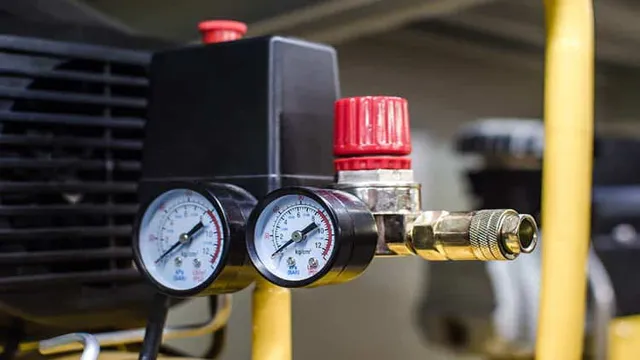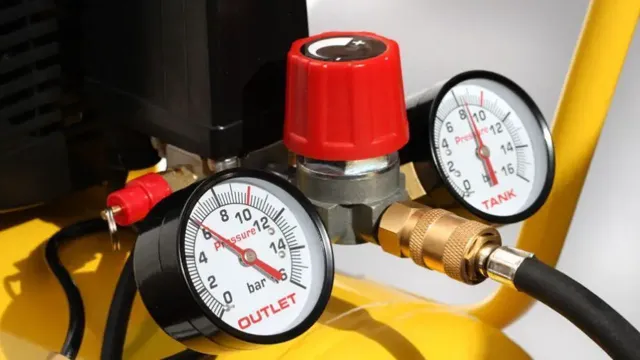How to Adjust Air Compressor Governor: A Step-by-Step Guide for Proper Functioning

If you own an air compressor, you know how important it is to keep it in good working condition. One vital aspect of maintaining an air compressor is ensuring that the governor is properly adjusted. But what is a governor, and how do you adjust it? A governor is a device that controls the speed of an engine by regulating the amount of fuel or air that enters it.
In an air compressor, the governor keeps the pressure within a specific range to prevent damage to the compressor or its components. In this blog post, we’ll explain how to adjust an air compressor governor, so you can keep your compressor running smoothly and efficiently.
What is an Air Compressor Governor?
Adjusting an air compressor governor is an important task for any air compressor owner. But what exactly is an air compressor governor? Simply put, it is a device that regulates the speed and pressure of the air compressor pump. This ensures that the compressor operates safely and efficiently.
The governor sits between the compressor’s motor and pump and controls how much air is being produced. Adjusting the governor allows the operator to control the maximum pressure and flow rate, preventing over-pressurization and potential damage to equipment. To adjust the governor, first consult your air compressor’s manual and locate the governor adjustment screw.
Turn it clockwise to increase pressure and counterclockwise to decrease pressure. Remember to make small incremental adjustments and test the compressor frequently to ensure that it is operating safely and efficiently. By properly adjusting your air compressor governor, you can extend the life of your system and prevent costly breakdowns.
Explanation of the Governor’s Use
An air compressor governor is a mechanical device that regulates the air pressure generated by an air compressor. The governor controls the speed of the compressor by adjusting the amount of air that is released when the pressure reaches a certain level. This helps to maintain a consistent flow of air and prevents the compressor from overloading or underperforming.
The governor achieves this by monitoring the pressure within the air receiver tank and adjusting the compressor’s throttle valve to maintain the desired pressure. Think of it like a traffic cop regulating the flow of cars on the road to prevent accidents and traffic jams. The governor ensures that the air compressor operates efficiently, reducing wear and tear on the compressor’s components, ultimately prolonging its lifespan.
Overall the air compressor governor plays a vital role in ensuring safe and reliable operation of air compressors.

Why Adjust the Governor?
If you’re wondering how to adjust an air compressor governor, you’re in the right place. The governor on an air compressor is responsible for controlling the amount of pressure in the tank. If your compressor is not performing well or is producing inconsistent results, adjusting the governor may help.
First, locate the governor on your compressor, which is typically a knob or screw on the pressure switch. Then, determine the target pressure you want your compressor to output. After that, adjust the governor clockwise to increase pressure, or counterclockwise to decrease pressure until you reach your desired target pressure.
It’s essential to note that you should always adjust the governor when the compressor is not running and ensure that the pressure switch is in the off position. With some practice, adjusting the governor on your air compressor can become second nature, resulting in better performance and consistency.
Benefits of Adjusting the Governor
Adjusting the governor on your engine can bring about a number of benefits, including improved performance, increased fuel economy, and a longer lifespan for the engine. The governor regulates the speed at which your engine runs, and a properly adjusted governor can help your engine run at the most efficient speed for the task at hand. This means that your engine will use less fuel to do the same amount of work, which can save you money over time.
Additionally, by preventing your engine from running at excessively high speeds, adjusting the governor can help reduce wear and tear on the engine’s moving parts, which can help prolong its lifespan. So if you’re looking to get the most out of your engine, adjusting the governor is definitely something worth considering.
How to Check the Governor?
If you’re wondering how to adjust your air compressor governor, the first step is to locate it. Usually, it’s located on the side of the compressor, near the pressure switch. Before attempting to adjust the governor, make sure to turn off the compressor and unplug it from the power source.
Once you’ve located the governor, you can adjust it by turning the screw on top of the governor. Turning the screw clockwise will increase the pressure, while turning it counterclockwise will decrease it. Start by adjusting the pressure to the minimum level required for your application, and then gradually increase it until you reach the desired pressure.
Be sure to test the compressor after each adjustment and adjust the pressure as necessary until you achieve the desired results. With a little bit of patience and practice, you’ll soon be able to adjust your air compressor governor with ease.
Step-by-Step Guide for Checking the Governor
Are you experiencing engine problems with your vehicle? Perhaps you suspect that the governor is not working correctly? The good news is that checking the governor is relatively simple, and you can do it yourself. Firstly, locate the governor arm, which is usually situated on the carburetor side of the engine. Then, check for any damage or wear on the arm or linkage and lubricate all moving parts.
Ensure the spring between the carburetor and the governor arm has the correct tension. Lastly, test the governor by running the engine at a constant speed and releasing the throttle. If the engine speed remains constant, then the governor is working correctly.
Checking the governor regularly is vital in ensuring your engine performs optimally and can prevent costly damage to your vehicle.
How to Adjust the Governor?
Adjusting the governor on an air compressor can seem daunting but it’s actually quite simple once you know what to do. The governor is responsible for regulating the speed of the compressor’s motor so it doesn’t exceed a certain level. If you need to adjust the governor because the motor is running too fast or too slow, start by locating the governor assembly on your compressor.
It’s usually on the side of the engine and has a linkage that connects to the carburetor. Next, locate the adjustment screw on the governor assembly and loosen it slightly with a screwdriver. Use a tachometer to measure the engine RPMs and adjust the governor to the desired speed by turning the adjustment screw clockwise to increase the RPMs or counterclockwise to decrease them.
Be careful not to adjust it too much as you can damage the engine. If you’re unsure about adjusting the governor on your air compressor, it’s always best to consult the owner’s manual or a professional mechanic.
Step-by-Step Guide for Adjusting the Governor
Adjust the Governor Adjusting the governor of your engine can be a tricky process, but it can greatly affect the performance of your equipment. The governor is responsible for controlling the speed of the engine and preventing it from running too fast. To adjust the governor, you will need to first locate it on the engine.
Then, you will need to loosen the governor arm and rotate it in the direction you want the engine to run. If you want the engine to run slower, rotate the arm counterclockwise. If you want the engine to run faster, rotate the arm clockwise.
Once you have made your adjustment, tighten the governor arm and check the engine’s RPM with a tachometer. Repeat the process until you achieve the desired RPM. It’s important to remember that adjusting the governor can be dangerous and should only be attempted by experienced individuals.
Always refer to the manufacturer’s instructions before making any adjustments.
Conclusion
In the world of air compressors, the governor is the wise old sage that keeps everything in balance. It’s responsible for ensuring that the air pressure stays within the desired range, and doesn’t go rogue and cause chaos. But like any wise old sage, sometimes it needs a little adjustment to keep things running smoothly.
With patience and care, adjusting the governor is a straightforward process that will keep your compressor humming along smoothly. So don’t be afraid to take on the challenge – just remember to approach it with wisdom and respect, and you’ll be rewarded with a machine that keeps on delivering.”
FAQs
What is an air compressor governor and its purpose?
An air compressor governor is a device that regulates the air pressure produced by an air compressor. Its purpose is to maintain a consistent air pressure level for the various applications of the compressed air.
How do I adjust the air compressor governor?
To adjust the air compressor governor, start by turning off the compressor and releasing all pressure. Then, locate the governor and adjust the set screw to your desired pressure level.
What is the ideal pressure level for an air compressor governor?
The ideal pressure level for an air compressor governor varies depending on the application. However, a common range is between 90 and 120 psi.
How often should I check the air compressor governor?
It is recommended to check the air compressor governor at least once a month to ensure it is working correctly and producing the desired pressure level.
What happens if the air compressor governor is not adjusted correctly?
If the air compressor governor is not adjusted correctly, the air pressure level can be too high or too low, leading to damage to the compressor or the equipment being powered by the air compressor.
Can I adjust the air compressor governor without a set screw?
It depends on the specific type of air compressor governor. Some models require a set screw for adjustment, while others may have a different type of adjustment mechanism.
What are some common issues with an air compressor governor?
Some common issues with an air compressor governor include leaks, damaged components, and incorrect pressure levels. Regular maintenance and inspections can help prevent these issues.



